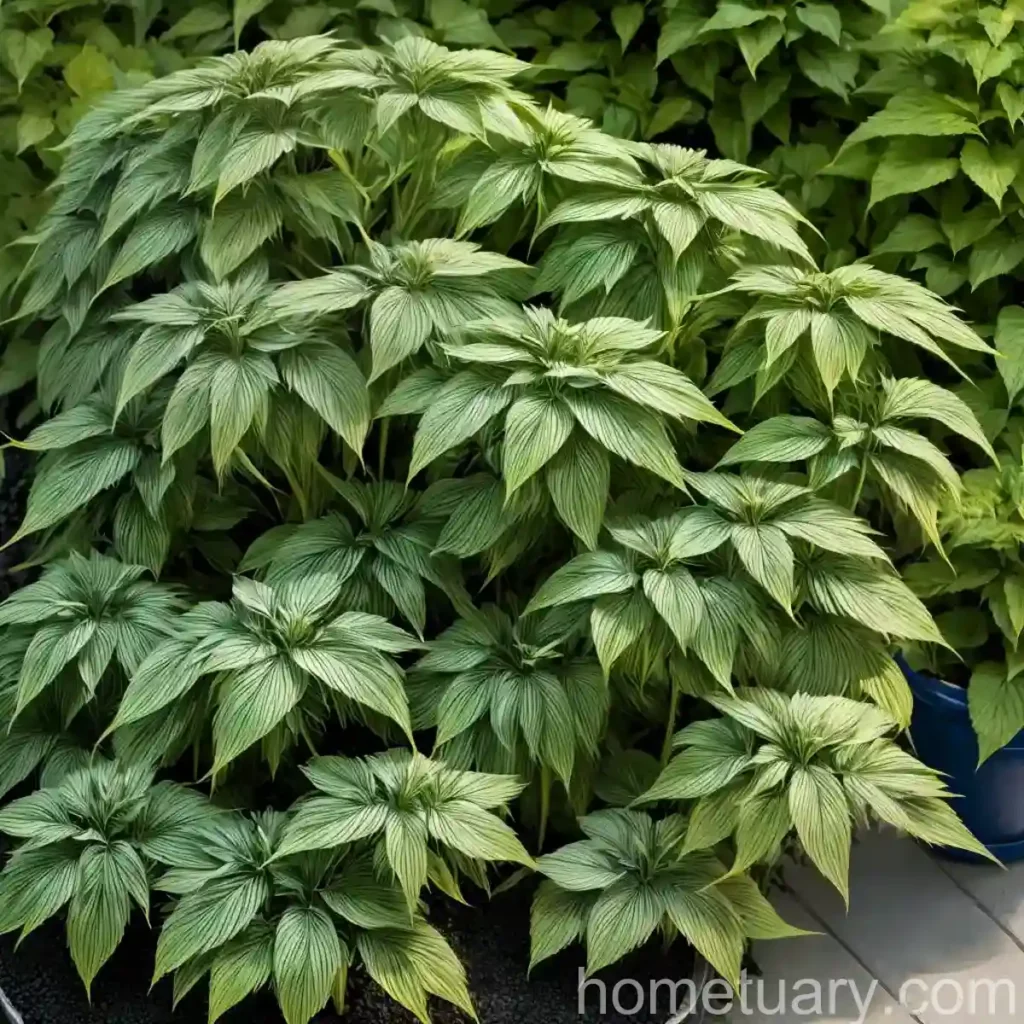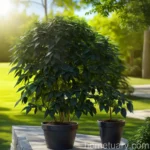What is the Japanese Spikenard (Aralia cordata ‘Sun King’)?
In the realm of horticulture, the Japanese spikenard, scientifically known as Aralia cordata ‘Sun King’, stands out as one of the most captivating and sought-after plants. Renowned for its resplendent foliage and versatility, this species has garnered a dedicated following among gardening enthusiasts. From its cultural significance to its nuanced care requirements, the Japanese spikenard encompasses a diverse array of facets that beckon exploration. This article presents an in-depth examination of the Japanese spikenard, encompassing its cultural significance, uses, as well as the essential factors for its care and maintenance.
Key Takeaways – Japanese Spikenard (Aralia cordata ‘Sun King’)
Before delving into the intricate details of Japanese spikenard, let’s encapsulate its essence through essential key takeaways, framing the fundamental aspects of its care and cultivation.
- Scientific Name: Aralia cordata ‘Sun King’
- Sunlight Requirements: Partial to full shade
- Watering Needs: Moist, well-draining soil
- Soil Conditions: Rich, fertile soil with good drainage
- Fertilizer Needs: Balanced, slow-release fertilizer
- Pruning: Regular removal of dead or damaged foliage
- Propagation: Division or seed propagation
- Common Diseases: Powdery mildew, leaf spot
- Common Pests: Aphids, spider mites
With these foundational points in mind, we embark on a comprehensive exploration of the Japanese spikenard, unraveling its cultural significance, utility, and the intricate nuances of its care and maintenance.
Perennial Beauties: Cultural Significance and Uses
Cultural Significance
The Japanese spikenard, Aralia cordata ‘Sun King’, derives its name from its lineage, with “Aralia” denoting its association with the Araliaceae family, while “cordata” alludes to its heart-shaped leaves. This species is native to regions of Japan, where it holds cultural significance in traditional practices and folklore. Revered for its aesthetic allure and reputed medicinal properties, the Japanese spikenard has etched its place in Japanese culture and horticulture.
Uses
The multifaceted utility of the Japanese spikenard spans various domains, from ornamental landscaping to culinary and medicinal applications. Notably, its vibrant foliage and striking appearance render it an esteemed presence in garden landscapes and floral arrangements. The leaves, with their resplendent golden hue, exude an alluring charm, making them ideal for adding a touch of opulence to floral compositions.
Moreover, the Japanese spikenard holds historical relevance in herbal medicine, where certain parts of the plant have been traditionally utilized for their purported therapeutic properties. Its roots have been attributed with medicinal potential, often employed in traditional herbal remedies. Beyond its ornamental and medicinal attributes, the Japanese spikenard embodies a rich tapestry of cultural and historical significance.
Care Essentials for Japanese Spikenard (Aralia cordata ‘Sun King’)
Caring for Japanese spikenard encompasses a spectrum of considerations, ranging from its watering regimen to soil preferences and sunlight requirements. In this section, we delve into the pivotal aspects governing the well-being of this resplendent plant.
Water
Sufficient moisture is integral to fostering the optimal growth and vitality of Japanese spikenard. Maintaining consistently moist soil, without allowing it to become waterlogged, fosters an environment conducive to its flourishing. As a general rule, it is advisable to water the plant when the top inch of the soil feels dry to the touch. However, it is crucial to steer clear of overwatering, which can lead to root rot and other detrimental repercussions.
Sunlight
When it comes to sunlight preferences, the Japanese spikenard thrives in partial to full shade, symbolizing its adaptability to varying light conditions. This attribute renders it suitable for shaded garden spaces where direct sunlight may be limited. Providing dappled sunlight or partial shade can effectively meet the light requirements of this species, underpinning its versatility as an ornamental plant.
Fertilizer
To enrich the growth and vitality of Japanese spikenard, a balanced, slow-release fertilizer serves as a pivotal aid. Incorporating a suitable fertilizer into the plant care regimen, particularly during the growing season, can fortify the plant with essential nutrients, bolstering its resilience and vigor. Adhering to the recommended dosage and application frequency is crucial to prevent nutrient imbalances and subsequent complications.
Soil
The soil composition plays a pivotal role in nurturing the Japanese spikenard, with rich, fertile soil characterized by good drainage serving as the quintessential habitat for this species. Loamy, well-draining soil enriched with organic matter constitutes an ideal medium for fostering the growth and sustenance of Japanese spikenard, underpinning its thriving potential.
Pruning
Regular pruning constitutes an integral facet of Japanese spikenard maintenance, facilitating the removal of dead or damaged foliage to promote a healthier, more vibrant appearance. Pruning also serves to maintain the desired shape and size of the plant, fostering a compact and aesthetically pleasing demeanor.
Propagation
The propagation of Japanese spikenard can be achieved through division or seed propagation, offering distinct avenues to expand the presence of this species in the garden landscape. Division of the plant during the growing season or sowing seeds for propagation enables the multiplication of Japanese spikenard, perpetuating its allure and ornamental presence.
Container Cultivation and Popularity
The adaptability of Japanese spikenard to container cultivation augments its appeal, making it a favored choice for various gardening enthusiasts seeking to adorn their indoor or outdoor spaces with its resplendent presence.
Container Popularity
The Japanese spikenard has amassed considerable popularity in container gardening circles, revered for its vibrant foliage and manageable size, rendering it well-suited for container cultivation. The compact nature of this species facilitates its accommodation in diverse container sizes, from smaller pots adorning interior spaces to larger containers embellishing outdoor landscapes.
Common Challenges: Diseases and Pests
The cultivation of Japanese spikenard necessitates vigilance and adept management of potential maladies and pest incursions that may impede its flourishing. In this segment, we acquaint ourselves with the common diseases and pests that pose challenges to the well-being of the Japanese spikenard.
Common Diseases
Powdery Mildew
The prevalence of powdery mildew among Japanese spikenard poses a notable concern, characterized by the emergence of powdery white patches on the leaves. This fungal affliction can impede the photosynthetic capabilities of the plant, necessitating prompt intervention to mitigate its impact.
Leaf Spot
Another prevalent disease affecting Japanese spikenard is leaf spot, marked by the appearance of conspicuous spots or lesions on the leaves. This affliction can compromise the vitality and aesthetic appeal of the plant, warranting diligent measures to curtail its progression.
Disease Diagnosis
Effectively diagnosing diseases afflicting Japanese spikenard entails a keen scrutiny of the visual symptoms manifested on the plant. Determining the specific malady based on symptomatic cues facilitates the implementation of targeted remedial measures, ensuring the restoration of the plant’s health and vigor.
Common Pests
Aphids
Aphid infestations represent a significant threat to the well-being of Japanese spikenard, with these tiny, sap-sucking insects capable of inflicting substantial damage. Vigilance in monitoring and early intervention are crucial in curbing the proliferation of aphids and safeguarding the vitality of the plant.
Spider Mites
Spider mites pose another formidable challenge, with their minute size and prolific reproductive capacity rendering them a persistent pest threat. These arachnids can wreak havoc on the foliage of Japanese spikenard, necessitating proactive measures to mitigate their impact and prevent widespread infestations.
Botanist’s Tips for Japanese Spikenard Care
Navigating the intricacies of Japanese spikenard care calls for adept insight and practical guidance, encapsulated through the following botanist’s tips that shed light on the nuanced aspects of cultivating and nurturing this resplendent species.
- Adequate Drainage: Optimal soil drainage is crucial for Japanese spikenard, preventing waterlogging and fostering a conducive growth environment.
- Moisture Monitoring: Regular monitoring of soil moisture levels enables the provision of suitable hydration, crucial for the well-being of this species.
- Pruning Precision: Precision in pruning practices is essential to promote a healthier and aesthetically pleasing appearance, underpinning the significance of judicious pruning techniques.
Fun Facts about Japanese Spikenard
Exploring the realm of Japanese spikenard unveils a trove of captivating and intriguing attributes that underscore its allure. Delving into some fun facts about this species provides a delightful insight into its captivating nature.
- The name “Sun King” aptly captures the resplendence and radiant allure of the golden foliage adorning Japanese spikenard, epitomizing its regal charm.
- Japanese spikenard serves as a magnet for pollinators, attracting bees and other beneficial insects with its nectar-laden blooms, thus contributing to the biodiversity of the garden ecosystem.
- The versatile utility of Japanese spikenard spans beyond its ornamental appeal, with its roots bearing historical significance in the realm of traditional herbal medicine.
Links to External Resources
Ensuring a comprehensive understanding of Japanese spikenard entails the exploration of external resources offering valuable insights, guidance, and diverse perspectives on the cultivation and care of this esteemed species. Delve into the following resources to further enrich your knowledge and expertise concerning Japanese spikenard:
- Royal Horticultural Society: Japanese Spikenard
- University of Florida IFAS Extension: Aralia cordata ‘Sun King’
- Missouri Botanical Garden: Aralia cordata
- Gardening Know How: Japanese Spikenard Planting and Care
Embark on an enriching journey of discovery by delving into these resources, empowering yourself with a diverse array of insights and expertise pertaining to Japanese spikenard.
In concluding this endeavor, the profound essence of the Japanese spikenard, encapsulated by its resplendent beauty, cultural significance, and nuanced care requirements, resounds with a timeless allure. As you embark on your horticultural odyssey with Japanese spikenard, may this endeavor be an enriching sojourn, brimming with rewarding experiences and the unrivaled splendor of this captivating species.
In the vibrant tapestry of nature’s creations, the Japanese spikenard stands as an emblem of botanical magnificence, an embodiment of regal charm and timeless allure. From its ornamental opulence to its cultural resonance, this resplendent species enthralls and fascinates, beckoning one and all to experience the enchanting embrace of its golden foliage and perennial grace. As we celebrate the multifaceted splendor of the Japanese spikenard, let us delve into its captivating realm, and immerse ourselves in the wondrous tapestry of nature’s bountiful offerings.















